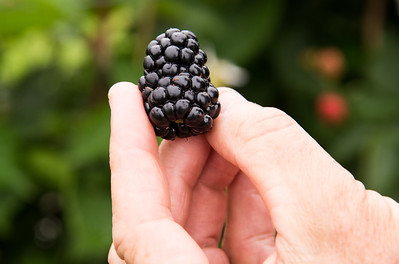Scientists assemble first complete genetic sequence for blackberries
May 25, 2023
By Fred Miller
U of A System Division of Agriculture
@AgNews479
Fast facts
- Scientists sequence, annotate first chromosome-length blackberry genome
- Team included researchers from seven countries
- Genomic information streamlines blackberry breeding efforts
(570 words)
PHOTO of Margaret Worthington
PHOTO of a primocane-fruiting blackberry
FAYETTEVILLE, Ark. — An international team of scientists has assembled the first complete sequence of the blackberry genome, creating a genetic tool that will help guide fruit breeders to develop new varieties with improved flavor, hardiness and other desired characteristics.
Margaret Worthington, associate professor and fruit breeder for the Arkansas Agricultural Experiment Station, the research arm of the University of Arkansas System Division of Agriculture, said this project yielded the first chromosome-length assembly and annotation of the blackberry genome.
Choice berry
Worthington collaborated with a team of 26 researchers from seven countries, including institutions in seven U.S. states. Together they assembled the genome of Hillquist, a wild blackberry with a unique fruiting habit discovered in 1949 by H.L. Hillquist, a gardener in Ashland, Virginia. It is the only known source of primocane-fruiting genetics and is the parent of every primocane-fruiting variety developed by public and private breeding programs.
Blackberry plants are perennial plants with biennial canes, or stems, that live for two years. The stems are known as primocanes in the first year and floricanes in the second year. Most blackberries only produce fruit on the floricanes. Primocane-fruiting blackberries flower and fruit on floricanes in the early summer and on primocanes in the late summer.
The University of Arkansas System Division of Agriculture released the first primocane-fruiting varieties, Prime-Jim® and Prime-Jan®, in 2004. Six of the division’s 21 blackberry releases are primocane-fruiting varieties.
Americans spent more than $656 million on blackberries in 2020, according to data from the 2022 Produce Market Guide cited in the research paper.
Putting it all together
Worthington pieced together the international team of scientists who used multiple advanced genetic tools to sequence and annotate the blackberry genome with high accuracy.
The group sequenced Hillquist blackberry and assembled the pieces into complete chromosomes. The scientists then examined the genome to build an accurate structural annotation — identification of the precise location of every DNA sequence that comprises a gene. They also developed a function annotation — a description of the likely function of each gene based on the roles of similar genes in other plants that were used as models.
A research paper about the genome project, titled “A chromosome-length genome assembly and annotation of blackberry,” was published in the February 2023 issue of G3, a genetics research journal published by Oxford University Press.
The completed genome has already proven helpful in the Division of Agriculture’s breeding program. “We have used the genome for a lot of things since then,” Worthington said. “We have several research papers already in progress that draw from this assembly.”
The blackberry assembly gave Worthington’s research group a starting point from which they were able to develop thousands of molecular markers and perform a genome-wide association study for the first time in blackberries, she said.
A genome-wide association study is an observational analysis of the genetic variants in huge numbers of individuals of the same species. The aim is to identify genes that are statistically associated with specific traits. The resulting information has a wide range of applications, including estimating the heritability of desirable traits in plants.
Worthington said this effort yielded diagnostic genetic markers for primocane-fruiting that the Arkansas fruit breeding team is using for the first time this year.
“Fieldwork will always be our bread and butter,” she said. “But it would be a mistake not to use modern tools to advance our program, to streamline it and make it more efficient.”
To learn more about Division of Agriculture research, visit the Arkansas Agricultural Experiment Station website: https://aaes.uada.edu/. Follow us on Twitter at @ArkAgResearch and on Instagram at @ArkAgResearch. To learn more about the Division of Agriculture, visit https://uada.edu/. Follow us on Twitter at @AgInArk.
About the Division of Agriculture
The University of Arkansas System Division of Agriculture’s mission is to strengthen agriculture, communities, and families by connecting trusted research to the adoption of best practices. Through the Agricultural Experiment Station and the Cooperative Extension Service, the Division of Agriculture conducts research and extension work within the nation’s historic land grant education system.
The Division of Agriculture is one of 20 entities within the University of Arkansas System. It has offices in all 75 counties in Arkansas and faculty on five system campuses.
Pursuant to 7 CFR § 15.3, the University of Arkansas System Division of Agriculture offers all its Extension and Research programs and services (including employment) without regard to race, color, sex, national origin, religion, age, disability, marital or veteran status, genetic information, sexual preference, pregnancy or any other legally protected status, and is an equal opportunity institution.
Media Contact: Fred Miller
U of A System Division of Agriculture
Arkansas Agricultural Experiment Station
(479) 575-5647
fmiller@uark.edu
Related Links
